
Concept explainers
(a)
To find: The intermediate value theorem and the table feature of the graphing utility to find the intervals one unit in length in which the polynomial function is guaranteed to have zero.
(a)
Answer to Problem 96E
Thezero lie in the range of
Explanation of Solution
Given:
The given function is
Calculation:
The zero of the polynomial by the table is shown below. Enter the function after the key Y=.
The snip for calculator is shown in Figure 1
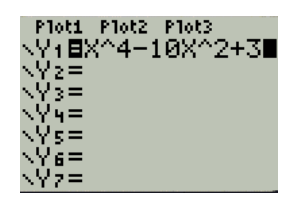
Figure 1
The table features obtained by pressing the keys
The given table is shown below.
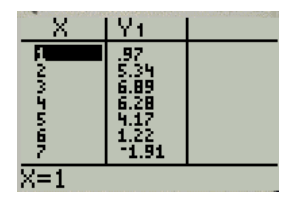
Figure 2
The table for the adjusted zero of the function is shown below.
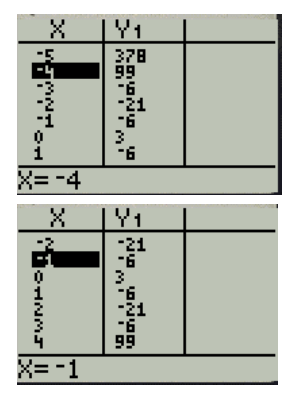
Figure 3
From the interval is in the range of
(b)
To find: The graph for the function to verify the zeros of the function.
(b)
Answer to Problem 96E
The values of the zero are
Explanation of Solution
Given:
The given function is
Calculation:
The result for the zeroes is verified by the pressing the 2nd and TRACE and then choosing the option 2.
The snip for it is shown in Figure 4
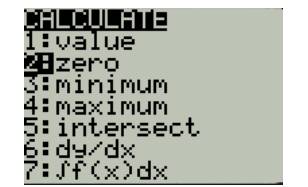
Figure 4
The next step is to move the arrow key and use the enter button to select the bounds on the left and the right. Thus, the zeros appear as,
The required diagram is shown in Figure 5
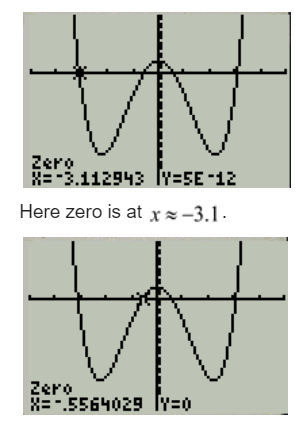
Figure 5
From the above Figure the zero is
The next step is to move the arrow key and use the enter button to select the bounds on the left and the right. Thus, the zeros appear as,
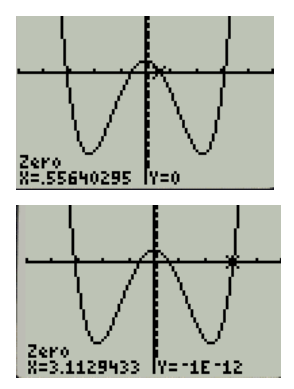
Figure 6
From the above Figure the zero is
From the above table the zero obtained are
Chapter 2 Solutions
Precalculus with Limits
- Solve the differential equation. 37 6 dy = 2x³y7 - 4x³ dxarrow_forwardFind an equation of the curve that passes through the point (0, 1) and whose slope at (x, y) is 3xy.arrow_forwardQ6. A fossil piece has been found in Alberta that contains 34% of C14 in it. What is the age of this fossil piece?arrow_forward
- Q5. Briefly explain what are isotopes of an elements, with an example, and why some isotopes are radioactive. 470arrow_forwardQ1. Will you earn more interest amount in two years by depositing $2000 in a simple interest account that pays 6% or in an account that pays 6.15% interest compounded monthly? tarrow_forwardQ4. We want to invest $18000 in an account compounded continuously. How long should the investment be kept so final value of the account reaches $25000 if the annual rate of interest is 5.8%?arrow_forward
- Q3. Determine the effective annual yield for each investment below. Then select the better investment. Assume 365 days in a year. a) 5.6% compounded semiannually; b) 5.4% compounded daily.arrow_forwardQ2. You deposit $22,000 in an account that pays 4.8% interest compounded monthly. a. Find the future value after six years. & b b. Determine the effective annual yield of this account.arrow_forward18. Using the method of variation of parameter, a particular solution to y′′ + 16y = 4 sec(4t) isyp(t) = u1(t) cos(4t) + u2(t) sin(4t). Then u2(t) is equal toA. 1 B. t C. ln | sin 4t| D. ln | cos 4t| E. sec(4t)arrow_forward
 Calculus: Early TranscendentalsCalculusISBN:9781285741550Author:James StewartPublisher:Cengage Learning
Calculus: Early TranscendentalsCalculusISBN:9781285741550Author:James StewartPublisher:Cengage Learning Thomas' Calculus (14th Edition)CalculusISBN:9780134438986Author:Joel R. Hass, Christopher E. Heil, Maurice D. WeirPublisher:PEARSON
Thomas' Calculus (14th Edition)CalculusISBN:9780134438986Author:Joel R. Hass, Christopher E. Heil, Maurice D. WeirPublisher:PEARSON Calculus: Early Transcendentals (3rd Edition)CalculusISBN:9780134763644Author:William L. Briggs, Lyle Cochran, Bernard Gillett, Eric SchulzPublisher:PEARSON
Calculus: Early Transcendentals (3rd Edition)CalculusISBN:9780134763644Author:William L. Briggs, Lyle Cochran, Bernard Gillett, Eric SchulzPublisher:PEARSON Calculus: Early TranscendentalsCalculusISBN:9781319050740Author:Jon Rogawski, Colin Adams, Robert FranzosaPublisher:W. H. Freeman
Calculus: Early TranscendentalsCalculusISBN:9781319050740Author:Jon Rogawski, Colin Adams, Robert FranzosaPublisher:W. H. Freeman
 Calculus: Early Transcendental FunctionsCalculusISBN:9781337552516Author:Ron Larson, Bruce H. EdwardsPublisher:Cengage Learning
Calculus: Early Transcendental FunctionsCalculusISBN:9781337552516Author:Ron Larson, Bruce H. EdwardsPublisher:Cengage Learning





